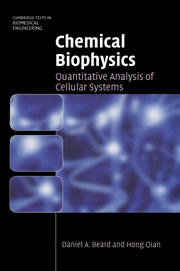Book contents
3 - Chemical kinetics and transport processes
Published online by Cambridge University Press: 05 June 2012
Summary
Overview
Differential equations are the backbone of computer modeling and simulation in fields ranging from astrophysics to ecology. Essentially, when differential equations are used to model the behavior of any system, including chemical reaction systems, a set of model equations is developed that mimics as faithfully as possible the essential behavior of the system. When a physical system, such as a living cell or tissue, is to be simulated, it is important not only that the behavior of the system is mimicked by the model equations, but also that the model equations are physically reasonable. Thus the principles of physical chemistry and thermodynamics presented in the previous chapters provide both laws that biochemical models must obey and a framework for building simulations that make physical sense. Our emphasis on physically realistic simulations is not necessarily appreciated by all practitioners in the field. Yet we believe that this emphasis is crucial for building simulations that not only mimic observed behaviors in biological systems, but also predict behaviors that are not easily observable or have not yet been observed.
Here we focus on the issue of how to build computational models of biochemical reaction systems. The two foci of the chapter are on modeling chemical kinetics in well mixed systems using ordinary differential equations and on introducing the basic mathematics of the processes that transport material into and out of (and within) cells and tissues.
- Type
- Chapter
- Information
- Chemical BiophysicsQuantitative Analysis of Cellular Systems, pp. 41 - 66Publisher: Cambridge University PressPrint publication year: 2008

